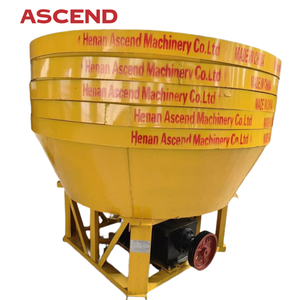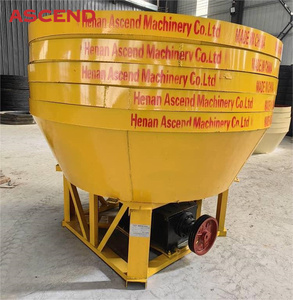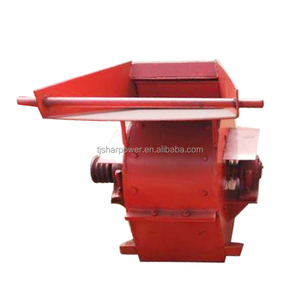
All categories
Featured selections
Trade Assurance
Buyer Central
Help Center
Get the app
Become a supplier

(8398 products available)





















An ore blender for mining is used in the mining industry to mix different materials before they are processed. This equipment helps make the content of metals in the ore more even. It also improves the efficiency of how the ore is separated from other elements. Ore blenders are essential in mining because they help reduce waste and ensure that smelting and refining companies get consistent quality ore.
Ore blenders or mixers are important in the mining industry because they ensure that the raw material fed into processing equipment is of consistent quality. When ore from different sources is blended together, the content of metals becomes more even. This makes it easier for mining companies to optimize their processes and reduces the chances of getting lower quality ore.
Heavy-duty mixers called ore blenders are made to last in tough mining conditions. They are built with strong parts that can handle the dust, heat, and wear that come from blending ore. Most ore blenders have rotating shafts with paddles or blades that mix the ore thoroughly so that all the different materials are evenly distributed. This ensures that every part of the ore is treated the same way in all the following processes. Ore blenders also have systems for getting rid of dust which help keep air quality good and stop machines from getting too dirty. These dust disposal systems collect any dust that is made when the ore is mixed together. They either compact it or send it through another process, preventing it from getting into the air and creating a health risk for workers.
When it comes to selecting ore blenders and mixers, some key factors must be considered to optimize blending processes and ensure efficient operation. The type of ore or material to be blended is crucial in deciding the most suitable blender. Different materials have varying characteristics, such as particle size, shape, weight, and moisture content, all of which affect blending efficiency and requirements. Understanding the properties of the material to be blended will help choose a blender designed for specific handling requirements.
A variety of ore blenders are used in the mining industry, including;
The functions and features of ore blenders for mining offer effective and efficient blending of ores to ensure consistent ore quality in the smelting process. It helps to improve the productivity and efficiency of mining operations.
Here are some of the common features of ore blenders for mining alongside their functions:
Feed Hopper
The feed hopper collects ore from a mine or stockpile. Afterward, a conveyor underneath the hopper moves the ore to a chute that distributes it evenly to the blending stockpile. The hopper and conveyor can hold a few hours' worth of ore before it goes to the mixer. This buffer prevents any sudden changes in the mine's output from affecting the smelting operation.
Apron Feeder
An apron feeder moves the blended ore from the stockpile to the rotary kiln. It is made of metal plates and runs at a slow speed. The feeder carefully supplies a steady amount of blended ore to the next part of the processing plant.
Blending Stockpile
The blending stockpile is a huge mound where ore from different sources mixes together. To make sure the blended ore is consistent, several radial stackers add ore to different parts of the pile as it slowly rotates. This process evens out any variations in grade or content and creates a uniform feeder for the smelter.
Sampling System
Miners use a sampling system to take a small amount of blended ore for testing. The automated system shows the grade and content of the stockpile through regular samples. Operators can adjust the blending process to maintain consistent ore quality using the data from the samples.
Dust Control
Mining and ore blending generate a significant amount of dust, which is a hazard to the workers and the environment. Effective dust control measures help mitigate this issue. They include water sprays, dust collection systems, shrouded conveyors, and enclosed transfer points.
Efficient Blending
Ore blend managers use advanced automation and real-time sampling to optimize ore blending. Their systems minimize human error, maximize blending efficiency, and improve the consistency of the final product. Blending managers can monitor all important parameters from a single control room to speed up decision-making processes.
Ore blenders have multiple uses in the mining industry beyond blending ores.
Blending Ores
The ore blender is meant to blend ores of different grades to create a blended product of a uniform grade. This product will then be fed to the processing plant. The objective of blending is to minimize the fluctuations in the grade of oregoing to the processing plant. Also, blending seeks to maximize the recovery of metal from the ore.
Batch Processing
Sometimes processing plants are set up to deal with specific ore types. In such cases, the ore blender will mix ores in a manner that allows for batch processing of a particular type of ore.
Reduction of Dust
During Handling and Transportation Dust is a major issue in mines. It causes several health problems for workers. Ore blenders add moisture to the ore, which helps reduce the dust. Dust reduction is beneficial for both the workers' health and the environment.
Heating and Cooling
The ore blender has the capability to heat or cool ore. This is important because some processes at the treatment plant may require the ore to be within a specific temperature range. Pre-processing ore to be at the required temperature saves time at the treatment plant.
Regulating Moisture Levels
Ore blenders regulate the moisture levels in the ore. Processing plants have specific moisture level requirements. Moisture levels can affect the handling and transportation of ore. Controlling moisture levels makes it easy to transport and handle ore.
Variable Feed Rates
Processing plants may have different feed rates at different times. The ore blender allows for adjustment of the feed rate in order to match the capacity of the processing plant.
Stockpile Management
The ore blender helps in efficient management of ore stockpiles. By mixing different ore types and grades, stockpiles can be managed more efficiently to ensure a smooth feed to processing plants.
For traders using ore blenders to pick up their business, the following tips will help them effectively select the right ore blender for their business:
Q: Is an ore blender for mining necessary?
A: No, it is not. It is, however, highly recommended. When blending ores of different grades, consistency is essential for proper processing and recovery. An ore blender ensures a balanced and homogenous blend, thereby increasing the efficiency of the smelting or leaching process and decreasing the expenses.
Q: What type of ore blender is more suitable for the mining industry?
A: The most suitable kind of ore blender is a batch-type ore blender. It is preferred because of its precision and flexibility. A batch-type ore blender allows accurate control of the blending process. This results in a consistent and controlled final product specification. The specifications can be modified to meet different plant requirements. Moreover, it is less expensive than a continuous ore blender.
Q: How can one ensure optimal operation of an ore blender?
A: Regular maintenance, operator training, and precise feed materials are key. Typical maintenance tasks include checking and replacing worn-out parts, such as seals and blades, and doing periodic checks. Operator training is very helpful, too. Well-trained operators enhance the ore blender's reliability and efficiency. Also, using the right feed materials helps optimize the ore blender's performance.
Q: What are the safety measures to take when using an ore blender?
A: Only blender operators trained and authorized to operate the machine should be allowed near the ore blender. They should follow all standard operating procedures. Warning signs should be placed in visible areas around the ore blender, and barriers should be used to keep people at a safe distance. All emergency stops on the ore blender should be clearly marked so that they are easily accessible in case of an emergency. Operators should also use proper PPE (personal protective equipment) at all times.